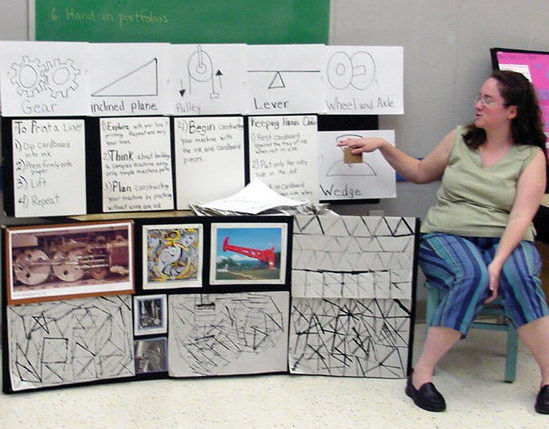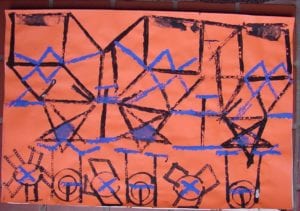Second graders studying “Simple Machines” during a science unit used line printing tools to practice creating levers, inclined planes, gears, wheels and pulleys.
Simple Machines

Smith College graduate student, Mimi Odgers developed this integrated science/art unit with Mrs. Hanno’s 2nd grade class at Bridge Street School in Northampton, MA. In this photo she discusses her project with the Teaching of Visual Arts class.
When students create simple machines and combine them to create complex machines they develop and practice
- awareness and understanding of different kinds of simple machines.
- inventive ways to print a machine.
- unique ways to use the line tools to create the parts that they need.
- a beginning understanding of the conversion of energy through machines.
Types of Simple Machines
lever
wheel and axle
gears
inclined plane
wedge
screw
pulley
Materials
- Large line tools- one per student, a few in reserve
- Small line tools – one per student
- Small curved line tools to share
- Large curved line tools to share
- 12 x 18” (30 x 46 cm) or larger
- One color of tempera paint in a squeeze bottle
- Trays for distributing paint
- Found objects, one per child (in reserve, if needed)
Setup
- Cover tables with newspaper if desired
- Practice paper at each student’s place
- Large line tool at each place
- Trays of paint in reserve until after children have time to practice
Is there anyone who can give us a definition or an example of a simple machine? What does a simple machine do?
A simple machine is a tool with few or no moving parts that you can use to help you to do work. It is a device that transmits or modifies force or motion. We use simple machines to make moving and lifting objects easier. Some examples of simple machines are the inclined plane, lever, wedge, wheel and axle, gears, pulley, and screw. These seven simple machines are used for transforming energy into work.
Ask children to look around their homes for simple machines and to bring in an example.
There are many sites on the internet for exploring simple machines. Here is one site that I found helpful.
https://elementalscience.com/blogs/science-activities/3-ideas-for-building-simple-machines-at-home
Display some simple machines like scissors, screw and screwdriver, nutcracker, garlic press, press for lemons and limes, cheese cutter, and discuss how they work – how they use force and motion to accomplish a task..

Discuss strategies for constructing simple machines using the line printing tools. Try creating levers, pulleys, gears, inclined planes, wedge, screw, wheel and axle Look especially for different ways to create the same machine. Can you figure out another way to print a gear?
It is important that children are familiar with the line printing process. They need time to experiment with the line tools before they can focus on creating simple machines.
Sequence the addition of the small straight line tool, the small curved line tool, and found objects as needed.
Practice using the line printing tools. Then try using the tools to create a few different simple machines. Here are a few examples.
Can you identify the simple machines in these practice prints?

Landon, age 8

Libby, age 8

Xiao Ping, age 8

Adrienne, age 8
Invent a Complex Machine
Create a complex machine by combining two or more “simple machines.”
- Brainstorm ideas for complex machines. (Water transporter, cookie factory, M & M Factory, and rock catapult were ideas suggested by a group of second graders.)
- Experiment on practice paper first to refine your idea.
- Then try another print. Your idea might change!
It is the children’s explanations, and the descriptive language that they use, that make these machines come alive. Have students write the name of their machine and explain what the machine does.
Initial ideas often work out the best, so save practice prints and be sure to have the children write their names on all their work.
Write about the machine you invented.
Students are usually eager to share ideas about their machines..
Consider asking students to write a name for their machine and a sentence or paragraph describing:
- the simple machines within the construction
- the function of the machine
- how the machine works
Bicycles, cars, trains, and trucks often emerge from machine printing explorations. A group of sixth-graders interested in machines started looking at the evolution of the car. Their teacher photographed cars from different time periods and from different points of view. He also made magazine photos of cars available for children to study.

Car (back view) by Doug, age 12

Beetle by Maureen, age 12

Massachusetts license plate by Sam, age 12

Roadster by Ingrid, age 12
These prints were created by students in Bob Hepner’s 6th grade studio art class.











